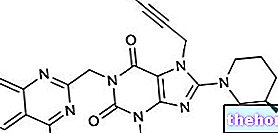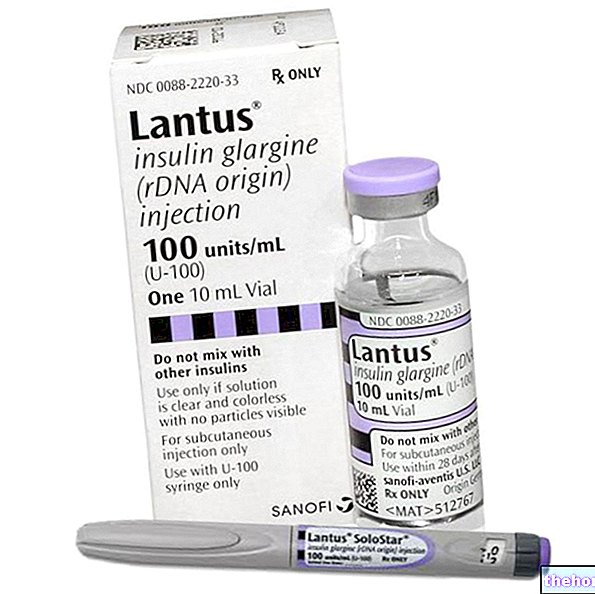ACTOS ® a drug based on Pioglitazone hydrochloride.
THERAPEUTIC GROUP: Oral hypoglycemic agents - Thiazolidinediones

Indications ACTOS ® - Pioglitazone
ACTOS ® is a drug indicated in the treatment of type II diabetes, in case of failure of non-pharmacological therapeutic measures such as balanced nutrition and correct lifestyle.
Pioglitazone could also be used in combination therapy with metformin or sulfonylureas, in case monotherapies alone are not able to produce good glycemic control.
In severe cases, ACTOS ® can also be effectively used in conjunction with insulin.
Mechanism of action ACTOS ® - Pioglitazone
The pioglitazone contained in ACTOS ® is a drug belonging to the pharmaceutical category of thiazolidinediones, with an important hypoglycemic activity.
Taken orally, it is rapidly absorbed in the intestine, with a bioavailability of 80% and with maximum plasma concentrations reached about 2 hours after intake.
After about 5-6 hours, pioglitazone undergoes an important hepatic metabolism, supported by enzymes belonging to the cytochrome category, with the subsequent elimination of its metabolites both in the urine and in the faeces.
The hypoglycemic efficacy of this compound is essentially due to the ability to reach insulin sensitive tissues and organs such as adipose, muscle and liver tissue, improving the peripheral activity of insulin and thus helping to support the hypoglycemic effect.
From a molecular point of view, this action is guaranteed by the ability of pioglitazone to activate PPAR gamma receptors, involved in the transcriptional modulation of various genes useful for regulating glucose and lipid metabolism and reducing the activation of the inflammatory process.
In other words, the activation of all these intracellular mechanisms takes the form of the possibility of reducing blood sugar by increasing the availability of peripheral and tissue glucose, and reducing the inflammatory process, which is very active at the vascular level, responsible for some of the most important consequences of diabetic pathology. .
Studies carried out and clinical efficacy
1. EFFECTIVENESS OF PIOGLITAZONE IN THE TREATMENT OF TYPE II DIABETES
Curr Med Res Opin. 2011 Feb; 27: 303-13. Epub 2010 Dec 9.
Study comparing the effect of pioglitazone in combination with either metformin or sulphonylureas on lipid profile and glycaemic control in patients with type 2 diabetes (ECLA).
Karamanos B, Thanopoulou A, Drossinos V, Charalampidou E, Sourmeli S, Archimandritis A; Hellenic ECLA Study Group.
Study conducted on about 2116 patients with type II diabetes and accompanied by an altered lipid profile. Administration of pioglitazone in patients unresponsive to metformin or sulfonylureas resulted in a reduction of glycosylated Hb by 1.5%, triglycerides by 21% and LDL cholesterol by 15%. These important results confirm the importance of treatment with pioglitazone on the health not only of the endocrine of the diabetic patient.
2. THE PROTECTIVE ROLE OF THE PIOGLITAZONE
Front Biosci. 2008 Jan 1; 13: 1813-26.
Mechanisms of anti-inflammatory and neuroprotective actions of PPAR-gamma agonists.
Kapadia R, Yi JH, Vemuganti R.
Pioglitazone has also been tested by various laboratories for its protective role against oxidative pathologies. More precisely, several studies show how the administration of this active ingredient can significantly reduce the damage induced by heart attacks, brain damage, strokes and oxidizing agents assuming an important protective action both vascular and nervous. This action, probably associated with the ability to modulate the production of inflammatory cytokines and at the same time enhance the antioxidant capacity of the body, allows to look at pioglitazone as an active drug in diabetic pathology not only in the control of glycemia but also in the prevention of vascular consequences. and nervous.
3. GENERIC OR ORIGINAL DRUG?
J Med Assoc Thai. 2010 Nov; 93: 1249-55.
Efficacy and safety of generic and original pioglitazone in type 2 diabetes mellitus: a multicenter, a double-blinded, randomized-controlled study.
Rawdaree P, Deerochanawong C, Peerapatdit T, Thongtang N, Suwanwalaikorn S, Khemkha A, Benjasuratwong Y, Boonyavarakul A, Chetthakul T, Leelawattana R, Ngarmukos C, Viwatwongkasem C, Pratipachunhan Tatrun N.,
The choice of the generic or the original drug is often one of the most important questions that both the doctor and the diabetic patient ask themselves. In this case, the study conducted demonstrates how Pioglitazone, both in the original form and in that of generic drug, can maintain the same effects and the same safety, guaranteeing a reduction in blood sugar, glycosylated hemoglobin and LDL cholesterol. Edema and migraine were observed in both groups.
Method of use and dosage
ACTOS ® Pioglitazone 30 mg tablets:
it is recommended to take 15 or 30 mg of pioglitazone per day in a single administration regardless of food intake.
Dosage adjustment may be required in elderly patients or in case of concomitant therapy with other hypoglycemic drugs.
ACTOS ® warnings - Pioglitazone
ACTOS ® therapy should be accompanied by periodic monitoring of different blood chemistry parameters such as:
- Glycemia: in order to properly modulate drug therapy;
- Transaminase: to monitor liver function and possibly suspend therapy when ALT levels exceed 3 times the upper limit;
- Hemoglobin: to monitor the possible decrease induced by pioglitazone.
careful and constant medical supervision is required in patients at risk of developing heart disease or predisposing factors, liver disease and bone fractures.
ACTOS ® tablets contain lactose which could cause the onset of gastrointestinal diseases in patients suffering from galactose intolerance or enzyme deficiency of lactase or glucose / galactose malabsorption.
It is also necessary to remember that combined therapy with sulfonylureas or insulin objectively increases the risk of hypoglycemia, which could reduce the patient's perceptive abilities, making the use of machinery and driving cars dangerous.
PREGNANCY AND BREASTFEEDING
Studies conducted on animal models have shown that the use of during pregnancy can significantly reduce fetal growth, probably reducing the fetal availability of glucose.
In the light of these data, and given the absence of clinical studies in the literature, ACTOS ® is contraindicated in pregnancy.
Furthermore, the presence of the active ingredient in breast milk limits its use even in the subsequent lactation period.
Interactions
Although the drug is metabolized in the liver by enzymes belonging to the cytochrome family, the number of potentially dangerous interactions from a pharmacokinetic point of view was limited.
In detail, the concomitant therapy with gemfibrozil or rifampicin required a further adjustment of the pioglitazone dosage in order to maintain its therapeutic properties unaltered.
Contraindications ACTOS ® - Pioglitazone
ACTOS ® is contraindicated in patients suffering from hepatic insufficiency, diabetic keto acidosis, hypersensitivity to the active substance or its excipients, history of cardiac pathologies including previous ones and during pregnancy and lactation.
Undesirable Effects - Side Effects
Pioglitazone therapy has often been accompanied by the appearance of numerous side effects, some of which are clinically relevant.
More precisely, visual disturbances, respiratory tract infections, weight gain, hypoesthesia, anemia, atralgia, hematuria, dizziness and edema have often been found, mainly concentrated in the initial treatment period.
Clinically more serious, but fortunately less frequent, reactions have affected the cardiovascular system with the onset of heart failure.
When ACTOS ® was administered in combination therapy with insulin, it was possible to observe a significant drop in glycemic that induced hypoglycaemia in predisposed or poorly compensated patients.
Note
ACTOS ® can only be sold under strict medical prescription.
The information on ACTOS ® - Pioglitazone published on this page may be out of date or incomplete. For a correct use of this information, see the Disclaimer and useful information page.




























